
views
Brainstorming a Diamante

Choose 2 nouns with opposite meanings. A diamante poem begins and ends with a noun and these 2 nouns are opposites of each other. Identify the first noun you want to use (topic A) and then choose a noun that is the opposite of that noun (topic B). Some examples include: Summer and winter Love and hate Men and women Cats and dogs
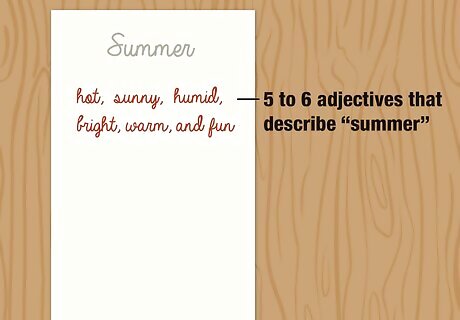
List 5 to 6 adjectives that describe topic A. An adjective is a descriptive word. You will only need 2 adjectives for your poem, but listing more than you will need will give you extra options to choose from. For example, if you are using summer as topic A, then you might list the words hot, sunny, humid, bright, warm, and fun. If you’re using cats as topic A, then you might list furry, stealthy, independent, cute, and soft.
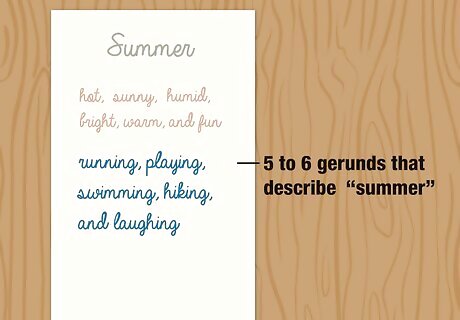
Choose 5 to 6 gerunds that describe topic A. A gerund is an action verb that ends in –ing. Make a list of 5 or 6 of these types of words to give yourself plenty of options. For example, if you’re using summer as your topic A, then you might choose words like running, playing, swimming, hiking, and laughing. If you’re using cats as topic A for your poem, then you might list hunting, sleeping, snuggling, playing, and purring.
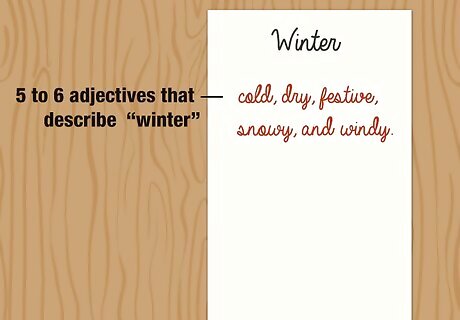
List 5 to 6 adjectives that describe topic B. You will only need 2 adjectives to describe topic B, but come up with 5 to 6 words so you have plenty of options. For example, if your second topic is winter, then you might list cold, dry, festive, snowy, and windy. If your topic B is dogs, then you might list loyal, protective, energetic, playful, and affectionate.
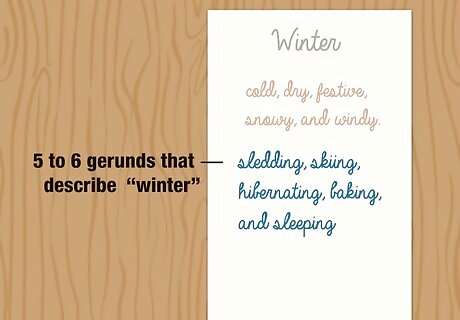
Choose 5 to 6 gerunds that describe topic B. Next, make a list of 5 or 6 gerunds for your second topic so that you will have options to choose from when you write the poem. For example, if your second topic is winter, then you might list sledding, skiing, hibernating, baking, and sleeping. If your second topic is dogs, then you might list barking, drooling, fetching, running, and playing.
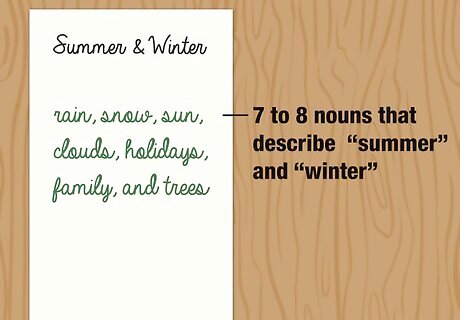
Make a list of 7 to 8 nouns that describe topic A and B. You will need 4 nouns total for your fourth line, but come up with as many as you can that describe both topic A and topic B. Try to come up with at least a few nouns that could apply to both topics. For example, if your diamante is about summer and winter, then the nouns could include rain, snow, sun, clouds, holidays, family, and trees. If your diamante is about cats and dogs, then you might list collar, fur, ears, whiskers, paws, treats, and toys.Tip: If you’re having trouble coming up with words, try looking up a word in a thesaurus for inspiration. For example, you could look up “hot” and get synonyms such as “fiery,” “blazing,” and “smoldering.”
Drafting a Diamante
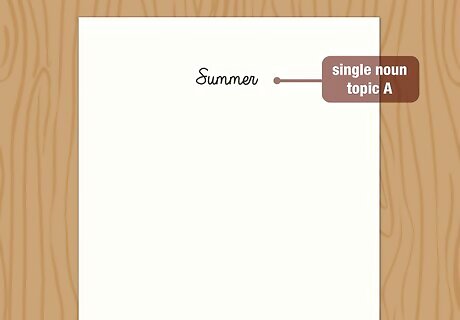
Choose a single noun to start the poem. Look at your list of opposite nouns and select the pair that you want to use for your poem. Decide which word will go in the first line and which will go in the last line. The word in the first line will be your first topic, or topic A. For example, if you choose summer and winter, then you might decide to place summer in the first line. Or, if you opt for cats and dogs, then you could start with cats and end with dogs.
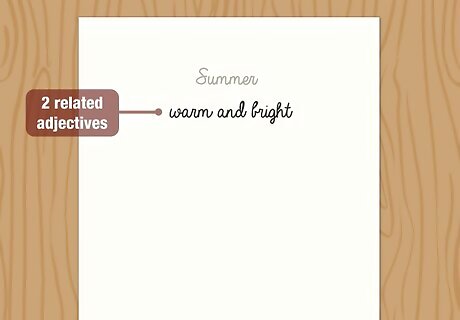
Follow the noun with 2 related adjectives in the second line. Look at your list of adjectives and choose 2 that you want to use for the second line of the poem. Opt for the 2 adjectives that best describe the topic. For example, if you started your poem with summer, then your adjectives might be warm and bright. If you started the poem with cat, then your adjectives might be stealthy and independent.
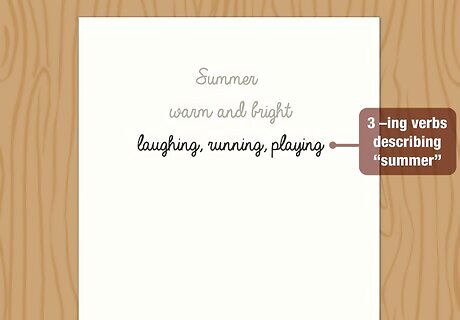
Put 3 –ing verbs in the third line of the poem. The third line should include 3 verbs that describe topic A and that end with –ing. Place these in the third line of your poem. For example, if your noun is summer, then you could use laughing, running, and playing as your verbs. If your noun is cats, then you might include the words hunting, sleeping, and purring.
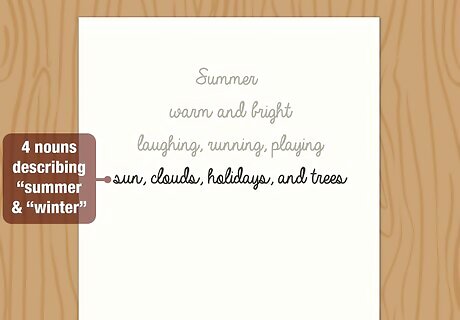
Fill the fourth line with 4 nouns that describe topic A and B. The fourth line of a diamante is the longest in the poem, but it still only has 4 words. You can choose 4 nouns that describe both topics, or you can list 2 words that describe topic A first, and then list 2 words that describe topic B. For example, if you’re using summer and winter, you could list sun, clouds, holidays, and trees in your fourth line. The first 2 nouns are more about summer whereas the second 2 nouns are more about winter. If you’re using cats and dogs for your diamante topic, then you could list whiskers, paws, ears, and toys.
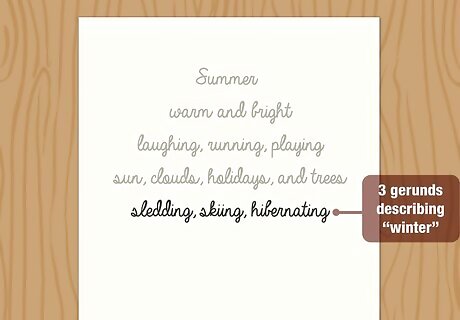
List 3 gerunds that describe topic B. Next, choose 3 gerunds from the list you made that describe topic B. Arrange them in the fifth line in the same way that you did for topic A. For example, if topic B is winter, then you might choose sledding, skiing, and hibernating. If your second topic is dogs, then you might choose barking, drooling, and fetching.
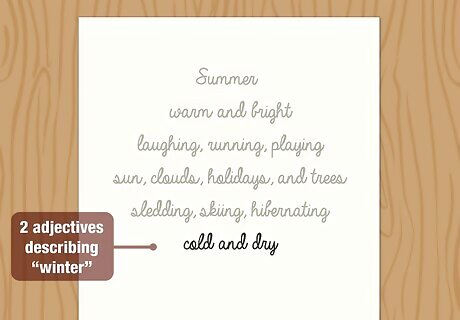
Choose 2 more adjectives to describe topic B. The sixth line only has 2 adjectives in it and these should describe topic B. Select these from the list of adjectives you made for topic B. For example, if topic B is winter, then you might use cold and dry. If your topic B is dogs, then you might choose loyal and protective.
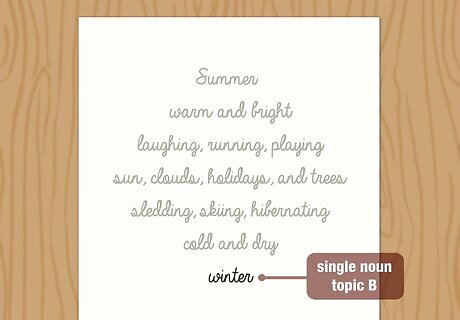
Finish your diamante with topic B. To conclude your diamante, all you have to do is write or type topic B. This should be the opposite of the noun you used for the first line of your poem. For example, if topic A is summer, then you would conclude your poem with winter. If topic A is cats, then you would conclude your poem with dogs.Tip: Try swapping out different words and changing the order of the words to see what you like best. For example, you might like the sound of “sledding, skiing, sleeping” better than “sledding, sleeping, hibernating” since the first option features 3 two-syllable words that all begin with an S.




















Comments
0 comment